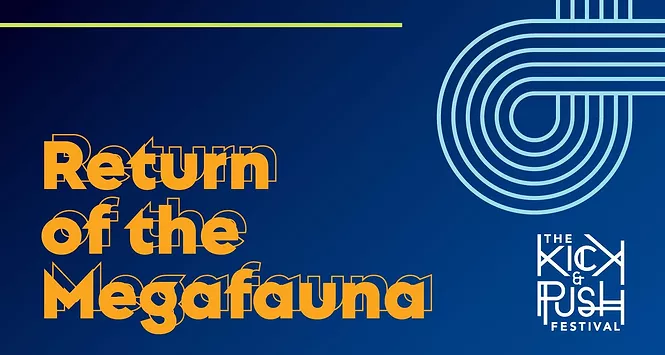De-extinction and Puppetry: Speaking with Seymour Irons

Return of the Megafauna created by Bad New Days is a physical theatre piece that was a part of the 2022 Kick and Push festival. The piece is contextualized through the company’s understanding of post-humanism and de-extinction, where the images of the future are utopic rather than dystopian. De-extinction is defined as the process of generating an organism that either resembles or is an extinct species.
I encountered the piece in the rehearsal hall of the Tett Centre, with four performers and two puppets creating a comforting viewing experience. Both puppets were sloths; one, extinct, as a full-scale body suit mostly conducted by a single person, and the other as a smaller sloth that still exists today. The smaller sloth was almost always conducted by three puppeteers, while the larger one would sometimes have the head manipulated by an additional person. I first noticed my good friend Seymour Irons standing by the tech booth. As the piece went on I discovered he was an integral part of the show, not only as a puppeteer but also within the creation process. I sat down a few days later to speak to him about his experience with the company.
This interview has been edited for clarity and length.
How has it been working with Bad New Days?
It was very rewarding in the sense that I’ve always wanted to work with a smaller team to try and build something. This way my creative input is heard during the making process instead of just the performing process. With this project it was about how things should move, not just how we should show it. The team was lovely to work with.
What were some things you learned during the process?
Puppeteering was probably the biggest thing. With puppeting, it is like putting your energy into this inanimate object to bring it to life. I learned how to do that. In my last performance with the Queen’s major [Not Wanted on the Voyage by Timothy Findley], I got to perform next to puppets but I never got to operate them. The puppets from both productions were created by Celia Scala; it was like a second chance at interacting with her work.
Though, at first the puppeteering was very difficult for me… I was unable to get just the arm movements – my whole body would be acting. I needed to figure out how to channel all of me into one limb. And learning that was very nice, it taught me to expand my focus.
What was something that really excited you about the work?
The movement. I especially liked the slow movement as a lot of the work I have done before was fast paced. Even if the piece is slow moving, it is still dramatic. There is still conflict within the work. It was interesting to move slowly and feel as if I was dancing with the puppet. It is very similar to how I would see a dance piece.
Was the movement something that was more regimented like ballet or would you say it was more improvisational?
Adam Paolozza trained the Bunraku style of puppetry. And I was not necessarily trained in it as it takes years to have that talent and training. But there were small pieces of the technique I learned. So I would say it was a mixture of improvisation and technique.
Some of the rules of Bunraku involve who is in charge of what, like I was in charge of the feet, and someone controlled the head and the right arm [of the puppet], while another controlled the other arm and the back. There is improvisation because, it’s like, you have to? But you are still going with the rhythm of everyone else at the same time.
Do you have any insights to the future production?
It is like an exploration of extinction from the perspective of plants and animals. From what I was told there’s not going to be much human involvement [outside of the puppeteering]. Maybe there will be a reaction to what we have historically known as humanity’s involvement in extinction but it seems to really centre around the movement of ecology.
What does de-extinction mean to you?
I’m still grappling with that. To be honest, I learned a lot about it from the project, and the scientists that are actually planning to go forward with this. I’ve also seen Jurassic Park. But to me, de-extinction is… No, we shouldn’t even call it that. It should be called something almost like reintegration or just integration because realistically, if these scientists were to “bring back” animals it would not be the same animal. It is something new, that is inspired by [an extinct animal], but is not the same animal. We could use de-extinction, but reintegration allows us to see the animals how they are now. To not try to associate them with how we expect them to be based on the past.
Is there anything else that you would want to just say generally about the experience, about things that you learned, anything at all?
Honestly, my perspective on [The Tortoise and the Hare] changed. I never understood how the slow guy won the race, because moving slowly doesn’t take much work. Though this project really showed me that it takes a lot more work and physicality than moving quickly.
Particularly with this work, the pace of the movement captures the audience’s perspective and attention for longer. There is so much merit in slow movement.
More information about Bad New Days can be found here.
